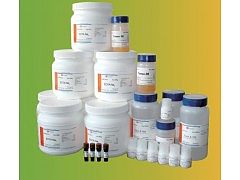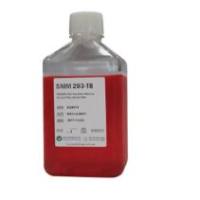Models of Inflammation: Carrageenan‐ or Complete Freund Adjuvant (CFA)
互联网
- Abstract
- Table of Contents
- Materials
- Figures
- Literature Cited
Abstract
Animal models of inflammation are used to assess the production of inflammatory mediators at sites of inflammation, the anti?inflammatory properties of agents such as nonsteroidal anti?inflammatory drugs (NSAIDs), and the efficacy of putative analgesic compounds in reversing cutaneous hypersensitivity. This unit details methods to elicit and measure carrageenan? and complete Freund's adjuvant (CFA)?induced cutaneous inflammation. Due to possible differences between the dorsal root sensory system and the trigeminal sensory system, injections of either the footpad or vibrissal pad are described. In this manner, cutaneous inflammation can be assessed in tissue innervated by the lumbar dorsal root ganglion neurons (footpad) and by the trigeminal ganglion neurons (vibrissal pad). Curr. Protoc. Pharmacol. 56:5.4.1?5.4.7. © 2012 by John Wiley & Sons, Inc.
Keywords: inflammation; carrageenan; complete Freund's adjuvant; edema; nociception
Table of Contents
- Reagents and Solutions
- Commentary
- Literature Cited
- Figures
- Tables
Materials
Basic Protocol 1:
Materials
|
Figures
-

Figure 5.4.1 (A ). Site of injection of substances into the footpad of the rat. (B ) Optimal area for paw punch biopsies to obtain consistent results. View Image -

Figure 5.4.2 (A ) Photograph of a footpad from an animal 24 hr after injection with 100 µl saline. (B ) Photograph of a footpad from an animal 24 hr after injection with 100 µl CFA (0.5 mg/ml). View Image -

Figure 5.4.3 Effects of ketorolac on carrageenan‐induced thermal hyperalgesia and edema. (A ) Thermal hypersensitivity in animals injected with saline (100 µl; animal tested 3 hr after injection) or carrageenan (100 µl of 0.5%; animal tested 3 hr after injection). Thermal hypersensitivity is expressed as the paw withdrawal latencies (sec) to a thermal stimulation using the Hargreaves apparatus. Ketorolac (10 mg/kg, i.p.; dark fill) administered 30 min prior to carrageenan injection completely reversed the inflammation‐induced thermal hypersensitivity ( p <0.05 determined by a t ‐test between vehicle‐ and ketorolac‐treated animals, n = 3/group). (B ) Edema induced by saline or carrageenan injection. The edema is expressed as the wet weight (mg) of paw punch biopsy mass. Ketorolac (10 mg/kg, i.p.; dark fill) administered 30 min prior to carrageenan injection partially reversed the inflammation‐induced edema ( p <0.05 determined by a t ‐test between vehicle‐ and ketorolac‐treated animals, n = 3/group). View Image
Videos
Literature Cited
| Literature Cited | |
| Bereiter, D.A., Hargreaves, K.M., and Hu, J.W. 2009. Trigeminal mechanisms of nociception: peripheral and brain stem organization. In Handbook of the Senses, Vol. 5, Science of Pain (M.C. Bushnell and A.I. Basbaum, eds.) pp. 435‐460. Elsevier, San Diego. | |
| Brittain, J., Duarte, D., Wilson, S., Wang, Y., Zhu, W., Ballard, C., Khanna, M., Brustovetsky, T., Schmutzler, B., Xiong, W., Ripsch, M., Ashpole, N., Hudmon, A., Meroueh, S., Hingtgen, C., Brustovesky, N., Jim, X., Vasko, M., Fehrenbacher, J., Hurley, J., White, F., and Khanna, R. 2011. Suppression of inflammatory and neuropathic pain by uncoupling CRMP‐2 from the presynaptic Ca2+ channel complex. Nat. Medicine 17:822‐829. | |
| Chaplan, S.R., Bach, F.W., Pogrel, J.W., Chung, J.M., and Yaksh, T.L. 1994. Quantitative assessment of tactile allodynia in the rat paw. J. Neurosci. Methods 53:55‐63. | |
| Cunha, T.M., Verri, W.A. Jr., Vivancos, G.G., Moreira, I.F., Reis, S., Parada, C.A., Cunha, F.Q., and Ferreira, S.H. 2004. An electronic pressure‐meter nociception paw test for mice. Braz. J. Med. Biol. Res. 37:401‐407. | |
| D'Amour, F. and Smith, D. 1941. A method for determining loss of pain sensation. J. Pharmacol. Exp. Ther. 72:74‐79. | |
| Donovan, J. and Brown, P. 2006. Euthanasia. Curr. Protoc. Immunol. 73:1.8.1‐1.8.4. | |
| Hargreaves, K., Dubner, R., Brown, F., Flores, C., and Joris, J. 1988. A new and sensitive method for measuring thermal nociception in cutaneous hyperalgesia. Pain 32:77‐88. | |
| Iadarola, M.J., Brady, L.S., Draisci, G., and Dubner, R. 1988. Enhancement of dynorphin gene expression in spinal cord following experimental inflammation: Stimulus specificity, behavioral parameters and opioid receptor binding. Pain 35:313‐326. | |
| Jackson, L.R. and Fox, J.G. 1995. Institutional policies and guidelines on adjuvants and antibody production. ILAR J. 37:141‐152. | |
| Mirshafiey, A., Cuzzocrea, S., Rehm, B., Mazzon, E., Saadat, F., and Sotoude, M. 2005. Treatment of experimental arthritis with M2000, a novel designed non‐steroidal anti‐inflammatory drug. Scand. J. Immunol. 61:435‐441. | |
| Otterness, I.G. and Moore, P.F. 1988. Carrageenan foot edema test. Methods Enzymol. 162:320‐327. | |
| Poh, K.W., Lutfun, N., Manikandan, J., Ong, W.Y., and Yeo, J.F. 2009. Global gene expression analysis in the mouse brainstem after hyperalgesia induced by facial carrageenan injection—evidence for a form of neurovascular coupling? Pain 142:133‐141. | |
| Randall, L.O. and Selitto, J.J. 1957. A method for measurement of analgesic activity on inflamed tissue. Arch. Int. Pharmacodyn. Ther. 111:409‐419. | |
| Schreiber, K.L., Beitz, A.J., and Wilcox, G.L. 2008. Activation of spinal microglia in a murine model of peripheral inflammation‐induced, long‐lasting contralateral allodynia. Neurosci. Lett. 440:63‐67. | |
| Singh, H. and Ghosh, M.N. 1968. Modified plethysmometer for measuring foot volume of unanesthetized rats. J. Pharm. Pharmacol. 20:316‐317. | |
| Stein, C., Millan, M.J., and Herz, A. 1988. Unilateral inflammation of the hindpaw in rats as a model of prolonged noxious stimulation: Alterations in behavior and nociceptive thresholds. Pharmacol. Biochem. Behav. 31:445‐451. | |
| Tall, J.M., Seeram, N.P., Zhao, C., Nair, M.G., Meyer, R.A., and Raja, S.N. 2004. Tart cherry anthocyanins suppress inflammation‐induced pain behavior in rat. Behav. Brain Res. 153:181‐188. | |
| Walker, K., Bowes, M., Panesar, M., Davis, A., Gentry, C., Kesingland, A., Gasparini, F., Spooren, W., Stoehr, N., Pagano, A., Flor, P.J., Vranesic, I., Lingenhoehl, K., Johnson, E.C., Varney, M., Urban, L., and Kuhn, R. 2001. Metabotropic glutamate receptor subtype 5 (mGlu5) and nociceptive function. I. Selective blockade of mGlu5 receptors in models of acute, persistent and chronic pain. Neuropharmacology 40:1‐9. | |
| Winter, C.A., Risley, E.A., and Nuss, G.W. 1962. Carrageenan‐induced edema in hind paw of the rat as an assay for antiiflammatory drugs. Proc. Soc. Exp. Biol. Med. 111:544‐547. | |
| Winter, C.A., Risley, E.A., and Silber, R.H. 1968. Antiinflammatory activity of indomethacin and plasma corticosterone in rats. J. Pharmacol. Exp. Ther. 162:196‐201. | |
| Woolfe, G. and MacDonald, A. 1944. The evaluation of the analgesic action of pethidine hydrochloride (Demerol). J. Pharmacol. Exp. Ther. 80:300‐307. | |
| Zhang, R.X., Lao, L., Wang, X., Ren, K., and Berman, B.B. 2004. Electroacupuncture combined with indomethacin enhances antihyperalgesia in inflammatory rats. Pharmacol. Biochem. Behav. 78:793‐797. |








